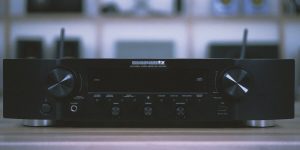Today, surround sound receivers come in a wide range and are actively used by many people to build individual multimedia systems. However, if you are a novice and want to buy your first receiver, you should (at least superficially) understand the basic technical characteristics of the device. The number of channels in a receiver is definitely one of those important technical aspects. In this article, I will consider this aspect in detail, no matter what set of channels you need in the receiver.
Generally, if you want to get quality sound, you need at least 5 channels. The thing is that 5-channel receivers are the bare minimum required for surround sound. Here I will discuss the meaning of the numbers in the channel count labeling, how to build an optimal multimedia system, and other important issues.
What do 2.0, 5.2 or 7.1.4 mean?

Before we proceed any further, it is crucial to clarify what numbers such as 2.0, 5.2, or 7.1.4 mean in AV receivers. So, let’s take 7.1.4 as an example. The first digit shows the set of supported speakers. The second number stands for subwoofers. In the example, it is 1. Finally, the third digit indicates the amount of supported overhead speakers.
Therefore, 7.1.4 AV receiver means that it supports 7 channels (speakers), a single subwoofer, and 4 overhead speakers. 7 channels include central, frond, and rare left & right speakers and two additional speakers located on sides for extra surround sound.
Stereo: 2.0 and 2.1channel systems
Without considering mono sound, the 2.0 setup is as simple as possible. While mono is only a single channel, the 2.0 device offers two separate speakers. For example, most modern hi-fi stereo systems focused on playing audio are 2.0 channel systems. While this setup is widely used for music, it can also be used for watching movies. Still, in this case, in terms of surround sound, one may expect to have only program emulations, which offer some immersive experience but are definitely far behind the 5.1 receivers.

2.0 channel systems can come in 2.1 versions. As you already know, 2.1 means that two speakers (left and right) are supplemented with a single subwoofer. While music requires mostly stereo without the subwoofer, it helps greatly when watching movies as it adds lows to the sound. Therefore, making it more bassy and deeper.
Surround sound: 5, 7, 9 and higher channel systems
As I have said, the best option is to refer to channels as speakers. Yet, this still doesn’t help get an idea of why one may need 9 channels instead of 5. So, to help you make the right decision, I will tell you about all these setups covering all their features and peculiarities, answering the most popular question of what channels mean on a receiver.

5 – channel receivers
When it comes to analyzing the receiver channel setups, the 5.1 configuration is the one that allows getting actual surround sound without any program emulations. Most frequently, this setup supports left & right stereo speakers, a dedicated front speaker, two rare speakers for surround sound, and a single subwoofer.
In this case, the central speaker is used to render dialogues, vocal parts in music, and user interactions in gaming. In addition, the front-left & right channels deliver sound effects and main instruments in music. In turn, the sounds that come from behind when playing will be played via rare left & right speakers.
7 – channel receivers
Naturally, a 7.1 channel receiver is the next step after the 5.1 one. The difference is that 7.1 and 7.2 systems also offer dedicated surround speakers for the left and right sides. So, in simple terms, apart from hearing sounds from your front and back, you will also enjoy sounds coming directly from the left and right.
9 – channel receivers and higher
So, if a 7.1 setup already distributes sound from all sides, then what can a 9-channel receiver bring to your home? 9 and more channel systems come with support for many channels that offer the multidimensional distribution of sound. Such a setup delivers a theatrical sound. Additional speakers in 9+ channel systems are often placed on the ceiling, making the sound incredibly immersive.
H2: How many channels do I need for Dolby Atmos and DTS:X?

Dolby Atmos requires at least two dedicated height channels as one of the fanciest ways of creating immersive home cinema setups. Therefore, if your goal is to run Dolby Atmos, you should look for systems at least version 2.0.2. Note, according to official recommendations from Dolby, the best option is to have 4 height speakers. The good news is that Dolby Atmos-enabled speakers are not required to run this feature. So, you can use your standard speakers for overhead audio.
Talking about DTS:X, it does not require dedicated height speakers. Yet, to get a fully immersive sound, you need at least a 5.1 setup with a receiver that supports it. It is worth noticing that DTS:X supports a maximum of 11.1 or 7.1.4 if we speak about setups with height speakers. Such a limitation comes from licensing issues. However, they already have DTS:X Pro that supports up to 30.2 speakers, which looks like total overkill.
We are supported by our audience. When you purchase through links on our site, we may earn an affiliate commission at no extra cost to you.
Our newsletter
* We will never send you spam or share your email with third parties

![Best Stereo Receivers [Reviewed and Tested]](https://mediapro-av.com/wp-content/uploads/2024/01/best-stereo-receiver-300x150.jpg)













